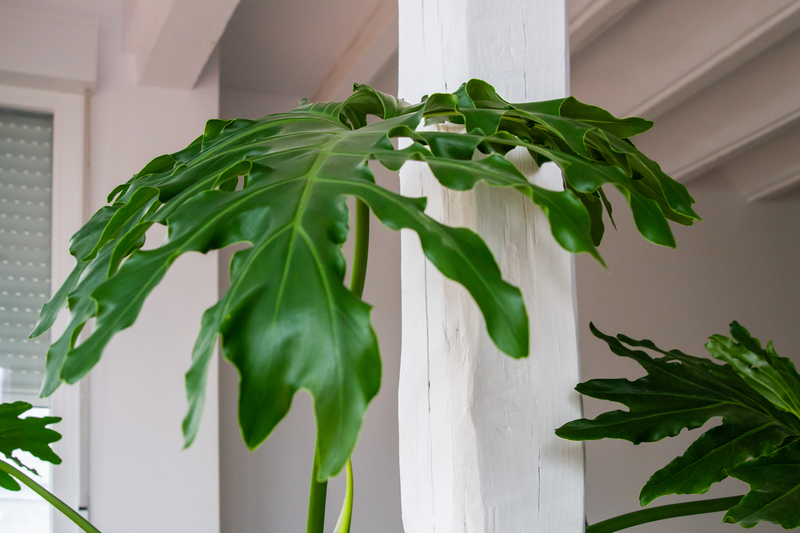A Swiss Cheese Plant stands out from other plants due to its holes, known as fenestrations. Originally from South America, this plant thrives in warmer conditions and environments with indirect sunlight. This plant is low-maintenance and is easy to propagate. Here’s how to care for a Swiss Cheese Plant!
What is the Scientific Name?
The scientific name for the Swiss Cheese Plant is Monstera deliciosa.
Other Names for a Swiss Cheese Plant
- Fruit Salad Plant
- Hurricane Plant
- Monkey Mask Plant
- Five Holes Plant
- Cheese Plant
Different Types
Monstera deliciosa, Monstera borsigiana, and Monstera obliqua.
What Soil Works Best for a Swiss Cheese Plant?
A regular peat-based potting mix that drains well works best for a Swiss cheese plant. Make sure to use a pot with drainage holes to reduce the chance of root rot. Also, the aerial roots of the plant need to cling on to something as the plant grows, so consider putting a moss pole, trellis, or stake in the potting soil and container to maximize growth.
Does this Plant Need Fertilizer?
A 20-20-20 liquid fertilizer works well for the Swiss cheese plant. After moving this plant into a new pot with fresh soil, you should use this 20-20-20 liquid fertilizer.
How Much Sun Does a Swiss Cheese Plant Need?
The plant does best with bright and indirect light. Avoid having this plant sit in an area with direct sunlight since it can scorch the leaves. If the indoor plant receives a few hours of direct sunlight during the day, you should put other plants in front of it or place a curtain over the window to reduce the sun’s glare.
What Temperature Works Best for Swiss Cheese Plant?
A minimum of 65 degrees Fahrenheit allows this plant to grow strong and healthy. However, keep this plant away from a cold window or AC unit. The cold and drastic temperature change does not work for this plant, so keep it in a place with a consistent temperature.
Do Swiss Cheese Plants Enjoy Humidity?
A Swiss Cheese houseplant thrives in an area with high humidity. To create a high humidity environment, you might want to place this plant in a bathroom with a shower. A hot shower will create a very humid climate, which this plant will enjoy.
Another way to increase the humidity around this plant is to invest in a humidifier. A humidifier running near the plant can help mimic that rainforest environment that the plant originates from in South America.
Finally, you can mist this plant and put pebbles in the soil to increase the humidity levels. The misting of the plant creates a bit of humidity, and the rocks help moisture evaporate around the plant over time.
How Often Should You Water a Swiss Cheese Plant?
This plant enjoys having moist but not soggy soil. To water the plant properly, you should ensure that the top inch or so of soil is wet. If the first inch or two of soil is dry, you will need to water the plant.
Overwatering is a common problem for new plant owners. Overwatering this plant can cause problems with root rot, so make sure you are only keeping the top inch of soil moist. Anything more than this, and you are giving the plant too much water.
What Size Does Swiss Cheese Plants Grow to Typically?
A Swiss cheese plant will grow around 4-8 feet tall inside a home or office. If you leave the plant outside, it can grow close to double that size. The plant only grows a foot or so wide, so it is perfect as an indoor houseplant.
What are the Most Common Bugs for this Plant?
Spider mites, mealybugs, and scale are common bugs with this plant. If these pests are present on the plant, you need to remove them immediately.
To remove bugs from the plant, you should put this plant in your sink or shower. From there, you spray the leaves down with soapy water to remove these bugs. You can also use a wet cloth with rubbing alcohol or neem oil to wipe down the plant leaves.
What are the Most Common Diseases?
Root rot is a common disease for a Swiss cheese plant. Overwatering occurs when you often water the plant and don’t have a pot with suitable drainage holes. If you have root rot, you need to remove the plant and transfer it into fresh soil.
It is also good to place the plant in an area with direct sun for a bit to completely dry out the roots. However, be careful not to leave the plant in direct sun for too long since that can scorch the leaves. Low/bright light works best for this plant in the long run once the plant dries out.
Another sign of overwatering the plant is yellowing leaves. Yellowing leaves signal that you are overwatering the plant. If that is the case, you can cut back on the watering frequency and place the plant in an area with indirect light.
How Do You Propagate a Swiss Cheese Plant?
Propagating a Monstera plant (Swiss Cheese Plant) is simple. You take stem cuttings that contain a leaf node and an aerial root and dip the ends in rooting hormone powder. From there, you put the cuttings into the water and let new roots form over time.
How Often Should You Repot Swiss Cheese Plant?
You can repot a Swiss Cheese plant every year since they are fast growers. Signs that the plant needs repotting are if the plant’s roots are starting to stick out of the bottom of the pot. If that is the case, you want to put the plant into fresh soil and place it in a container about 2 inches larger in diameter than the plant’s root ball.
Is a Monstera Plant Toxic?
A monstera plant (Swiss cheese plant) is toxic to digest for cats. Ingesting this plant can cause burning, so keep it away from your pets.
What is the Hardiness Zone for this Plant?
10-12 USA
Conclusion — Swiss Cheese Plant Care
In summary, this tropical plant is relatively easy to care for in your home or office. Since it only needs indirect light to grow, you don’t need it facing any particular window. Another great feature of the plant is how easy it is to propagate, which means you can add this plant throughout your home or give it as a gift to others!
Similar Posts:
How to Increase Humidity for Plants
How to Get Rid of Mold on Plant Soil
How to Take Care of a Watermelon Peperomia Plant
